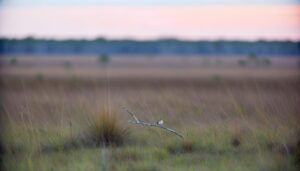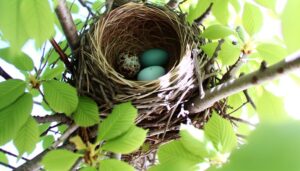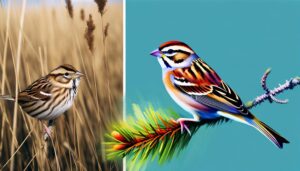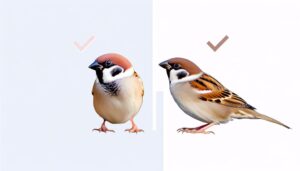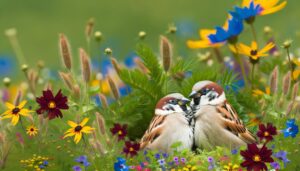How to Identify Common Sparrows in Southern California
Southern California hosts a variety of common sparrow species, including the Song Sparrow, known for its melodious trill; the adaptable, urban-dwelling House Sparrow; and the White-Crowned Sparrow, recognizable for its bold black and white striped head. These species each possess unique traits, from their habitats and diets to their distinct songs.
By exploring further into the world of sparrows, one will discover an intriguing mix of behaviors, from dynamic social structures to aerial courtship displays, that demonstrate the integral role they play in California's diverse ecosystems. Let us venture deeper into their intriguing world.

Key Takeaways
- Southern California is home to several sparrow species including the Song Sparrow, White-crowned Sparrow, and the introduced House Sparrow.
- Sparrows in Southern California play a crucial role in the ecosystem as seed dispersers and prey for larger birds.
- Each sparrow species in Southern California has unique characteristics, including distinct calls, dietary habits, and nesting preferences.
- Sparrows have adapted to urban environments in Southern California, using man-made structures for nesting and showing a high tolerance for city noise.
- Conservation efforts in Southern California focus on habitat restoration, controlling invasive species, and mitigating climate change effects to protect sparrow populations.
Understanding Sparrow Species
Diversity thrives in the world of sparrows, particularly in Southern California, where one can observe a multifaceted array of species, each with its unique characteristics and behaviors.
The Song Sparrow, distinguished by its streaked brown plumage and melodious trill, is a common sight in backyards and parks.
The White-crowned Sparrow, recognizable by its bold white and black striped head, prefers shrubby habitats and open fields.
The House Sparrow, an introduced species, is frequently spotted in urban and suburban areas, displaying an adaptable nature.
Each species has its own preferred habitat, diet, and nesting habits, contributing to the rich biodiversity in the region.
Understanding these variations is key for anyone interested in birdwatching or ornithology.
Sparrows' Role in the Ecosystem
Beyond their distinct characteristics and behaviors, sparrows play a vital role in Southern California's ecosystem, serving as both essential seed dispersers and prey for larger animals. These birds consume vast quantities of seeds, which in turn pass through their digestive system and are scattered around the area, thereby aiding in plant distribution and diversity.
Simultaneously, sparrows form a pivotal part of the food chain. They're often targeted by larger birds of prey, contributing to the natural balance within the ecosystem. This interplay is illustrated in the table below:
| Role in Ecosystem | Impact | Examples |
|---|---|---|
| Seed Dispersal | Enhances plant diversity | Eating and scattering seeds |
| Prey | Maintains food chain balance | Prey for hawks, owls |
Thus, sparrows are far from being mere bystanders in the ecosystem; they actively shape and sustain it.
Common Sparrow Habitats
In Southern California, the common sparrow exhibits remarkable adaptability to urban environments, a topic of interest to be explored.
Critical to their survival are their nesting habits and territorial behaviors, which offer insights into their ecological role.
Equally significant is their feeding patterns, as these directly impact their ability to thrive amidst human settlements.
Urban Sparrow Adaptations
Despite the bustling city landscape of Southern California, common sparrows have adeptly adapted to urban environments, utilizing man-made structures for nesting and foraging in highly trafficked areas. These birds display remarkable plasticity in their behavior and diet, showing a robust ability to exploit new resources.
Key adaptations include:
- Dietary Flexibility: They aren't picky eaters, consuming a variety of human leftovers alongside insects and seeds.
- Nesting Habits: Sparrows use crevices in buildings, traffic lights, and other structures for nesting, demonstrating resourcefulness.
- Noise Tolerance: They've adjusted to the constant city noise, even altering their song frequency to guarantee communication.
These evolutionary shifts allow sparrows to thrive amidst urban chaos, making them a prominent component of Southern California's cityscape.
Sparrow Nests and Territories
Common sparrows clearly stake out their territories, crafting intricate nests in a range of environments, from leafy suburban gardens to bustling urban areas, exhibiting an impressive adaptability to diverse habitats.
These birds construct their abodes primarily using plant materials like grasses, twigs, and leaves, ingeniously woven together to provide stability and insulation. The inner chamber is often lined with soft materials such as feathers or fur for added comfort.
Territorially, sparrows can be quite assertive, often defending their nesting sites from other birds, even species larger than themselves. Their territories generally cover a small radius around their nests, extending to the immediate feeding and foraging areas, but can vary according to factors such as food availability and the presence of predators.
Sparrow Feeding Habits
Remarkably adaptable, sparrows feed on a vast array of foods, primarily dining on seeds and insects, yet they're not above foraging for human scraps in urban areas. Their diet shifts seasonally, with seeds dominating during winter months and insects becoming the main source of nourishment in spring and summer. They're also known to consume small fruits and berries when available.
Here are three interesting aspects of sparrow feeding habits:
- Sparrows employ a feeding strategy known as 'scatter-hoarding', where they store food items in various locations for later consumption.
- They've adapted to urban environments, often seen hopping around outdoor dining areas, searching for crumbs.
- Sparrows are opportunistic feeders, adjusting their diet based on the availability of food sources.
Understanding these habits provides insight into their adaptability and survival strategies.
Identifying Sparrow Calls
Identifying sparrow calls requires a vital ear and an understanding of the unique sound patterns that characterize these birds. Each species emits distinct vocalizations that can be distinguished by their rhythm, pitch, and repetition.
Interpreting these calls correctly is important for accurate species identification and contributes importantly to the study of Southern California's sparrow populations.
Recognizing Distinct Sparrow Sounds
Listening closely to the chirps and songs in the early morning can help you decipher the distinct calls of Southern California's sparrows, each having its unique auditory signature.
The sounds these sparrows produce can be classified into three main categories, making it easier for enthusiasts to identify them.
- Chirps: Short, sharp sounds, often repeated, which serve as the sparrow's basic communication.
- Songs: More complex sequences of notes, often melodious, used primarily during mating season to attract partners.
- Alert calls: Loud, sharp sounds, used to warn other sparrows of potential danger.
Common Sparrow Call Patterns
In the pre-dawn hours, one can begin to discern the common call patterns of sparrows, each species exhibiting a unique combination of chirps, songs, and alert calls that define its aural identity.
Sparrows, like the familiar House Sparrow, often display a simple, repeated chirp, serving both as communication and territory marking.
The White-crowned Sparrow, on the other hand, distinguishes itself with a melodic song, punctuated by clear, high-pitched tones.
More subtle are the alert calls, such as those of the Song Sparrow, a sharp 'chink' indicating potential danger.
These variances in call patterns are essential identifiers, as sparrows often remain hidden, their voices being the prime signal of their presence.
Recognizing these patterns deepens our understanding of these common, yet complex, birds.
Interpreting Sparrow Vocalizations
Deciphering the unique vocalizations of sparrows, a listener can distinguish between species and even gather insights into their behaviors and interactions.
Sparrows, like many birds, use a variety of calls to communicate. These can range from simple chirps to complex melodies.
By paying close attention, one can become skilled at:
- Identifying a 'song', often used by males to attract mates and defend territories.
- Recognizing 'call notes', usually shorter and less musical, used for general communication or alarms.
- Differentiating between species based on unique vocal patterns.
This skill requires practice, but it's a fascinating way to deepen your understanding of these common Southern California sparrows.
Unique Sparrow Behaviors
Often observed darting across the sky, Southern California's sparrows exhibit a range of unique behaviors that capture the interest of birdwatchers and scientists alike. These passerine birds often show a vibrant social structure. They're known to gather in sizable flocks, where intricate pecking orders are established and maintained.
Sparrows are diurnal, most active during the day, and they're particularly lively at dawn and dusk. Interestingly, they engage in dust bathing, a peculiar ritual where sparrows flick dust onto their feathers – a behavior thought to deter parasites. They're also seen performing aerial acrobatics during courtship displays.
Additionally, sparrows display food caching behavior, a rare trait among birds, storing surplus food for leaner times. These behaviors, among others, make sparrows uniquely fascinating.
Conservation Efforts for Sparrows
While the fascinating behaviors of Southern California's sparrows captivate many, it's their precarious conservation status that's currently grabbing the attention of environmentalists and ornithologists. There's a crucial focus on restoring their dwindling habitat, controlling invasive species, and taking measures to mitigate climate change effects on their breeding and feeding grounds.
Key conservation efforts include:
- *Habitat Restoration*: Recreating native plant communities to provide sufficient food sources and nesting sites.
- *Control of Invasive Species*: Reducing competition for resources by managing invasive bird species.
- *Climate Change Mitigation*: Implementing strategies to lessen the impact of climate change on sparrows' habitats.
These concerted efforts are essential to guarantee the continued survival and flourishing of these avian species. Detailed understanding and strategic implementation are the foundations of these conservation endeavors.
Encountering Sparrows in Southern California
Birdwatchers and nature enthusiasts alike can encounter a variety of sparrow species throughout Southern California, each offering unique glimpses into their diverse behaviors and adaptations.
The white-crowned sparrow, for instance, is often seen foraging in open areas, while the song sparrow prefers shrubbery. Observers may spot the rufous-crowned sparrow in rocky environments, its earth-toned plumage providing perfect camouflage.
In urban spaces, one might encounter house sparrows, their adaptability evident in their ability to thrive in these human-dominated landscapes. Encountering these sparrows, with their distinctive markings, songs, and behaviors, provides valuable insight into the richness of avian life in Southern California.
Careful observation can reveal intricate social dynamics and survival strategies, enriching our understanding of these ubiquitous birds.
Conclusion
In the grand tapestry of Southern California's biodiversity, sparrows lend their own subtle, yet important, threads. These small birds, often overlooked, play a crucial role in our ecosystem, from seed dispersal to insect control. Their distinctive calls and unique behaviors enrich our natural surroundings.
Yet, they face threats that demand our attention. So, next time you encounter a sparrow, remember, they're not just part of the scenery, but key players in our environmental symphony.

